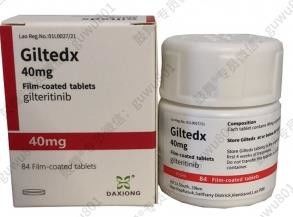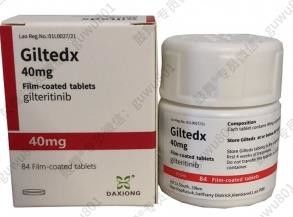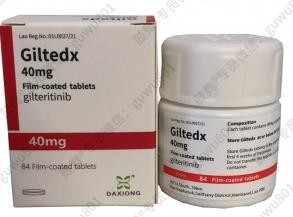[Drug Name]
Generic Name: Giritinib Fumarate Tablets
Trade Name: XOSPATA
English name: Gilteritinib Fumarate Tablets
Hanyu Pinyin: Fumasuan Jiruitini Pian
[Indications
This product is intended for the treatment of adult patients with relapsed or refractory acute myeloid leukemia (AML) who carry a mutation in FMS-like tyrosine kinase 3 (FLT3) as detected by a well-validated assay.Refer to Dosage and Administration for FLT3 mutation testing requirements.
This product is an urgent clinical need, based on overseas data and pharmacokinetic data from Chinese subjects to obtain conditional approval for marketing, the effectiveness and safety of the treatment of Chinese patients has to be further confirmed after marketing.
[Usage and dosage]
patient choice
Prior to the administration of giritinib fumarate tablets, patients with relapsed or refractory AML must be determined to have an FLT3 mutation (internal tandem repeat [ITD] or tyrosine kinase domain [TKD]) in their peripheral blood or bone marrow. Validated assays should be used to determine a patient's FLT3 mutation status. Patients who are judged to harbor FLT3 mutations by the results of FLT3 mutation testing in hospitals or laboratories are able to receive treatment with this product; patients should be retested for FLT3 mutation status using an investigational companion diagnostic assay at hospitals designated by Astellas Pharma (China) Ltd. and the results of the assay confirm that the patient carries a FLT3 mutation and can continue to use the drug.
usage
Initiate and supervise treatment with this product by a physician experienced in antitumor therapy.
This product is used orally.
Can be taken with or without meals. Tablets should be taken whole with water, not broken or crushed.
This product should be taken at approximately the same time each day. If a dose is missed or not taken at the scheduled time, it may be taken as soon as possible on the same day, but should be made up 12 hours before the next scheduled dose. You should resume your scheduled dose the next day. If vomiting occurs after taking the dose, the patient should not repeat the dose, but should continue to take the dose at the scheduled time the following day. The interval between doses should not be shorter than 12 hours.
Patients may be restarted on this product after hematopoietic stem cell transplantation (HSCT) (see Table 1).
dosages
The recommended starting dose of giritinib fumarate tablets is 120 mg (3 x 40 mg tablets) once daily for a 28-day treatment cycle. Treatment with this product should be continued until the patient no longer experiences clinical benefit or develops unacceptable toxicity. Because clinical remission may be delayed, consideration should be given to continuing treatment at the prescribed dose for up to 6 treatment cycles to ensure adequate time to achieve clinical remission.
If one of the following scenarios is not achieved after 4 weeks of treatment, the dose should be increased to 200 mg (5 x 40 mg tablets) once daily as tolerated by the patient or as clinically assured:
Complete remission (CR, defined in the footnote to Table 3 of [Clinical Trial]);
Complete remission (CRp) was achieved by all criteria except incomplete platelet recovery [platelets <100 × 109/L];
Complete remission (CRi) was achieved by all criteria except that there was still neutropenia [neutrophils <1 × 109/L] with or without complete platelet recovery.
Blood counts and blood biochemistry evaluations (including creatine phosphokinase) should be performed prior to the start of treatment, weekly for the first treatment cycle, every 2 weeks for the second treatment cycle, and every treatment cycle thereafter.
An electrocardiogram (ECG) should be performed prior to the initiation of treatment with this product, on Days 8 and 15 of Cycle 1, and prior to the initiation of 2 subsequent cycles of treatment Patients with a QTcF>500 msec should have their treatment interrupted and the dose of this product reduced.
Dosage adjustment
▼ Table 1. Recommendations for Suspension, Downward Dose Adjustment, and Discontinuation of the Product in Patients with Recurrent or Refractory AML
Criteria This product is administered
Differentiation Syndrome
If differentiation syndrome is suspected, corticosteroids are given and hemodynamic monitoring is initiated.
Suspend giritinib therapy if severe signs and/or symptoms persist for more than 48 hours after initiation of corticosteroid therapy.
When signs and symptoms improve to grade 2 a or lower, restart giritinib therapy at the same dose.
Reversible posterior encephalopathy syndrome
Discontinue Giritinib.
QTc interval >500 msec
Suspension of giritinib therapy.
Giritinib therapy was restarted at the reduced dose (80 mg or 120 mgb) when the QTc interval returned to baseline values ±30 msec or ≤480 msec.
Cycle 1, day 8 ECG shows prolonged QTc interval >30 msec
ECG confirmation on day 9.
If confirmed, consider dose reduction to 80 mg.
Pancreatitis Symptoms
Interrupt giritinib treatment until the symptoms of pancreatitis disappear.
Restart treatment at the reduced dose of giritinib (80 mg or 120 mgb).
Other grade 3 a or higher toxicity considered to be treatment-related.
Interruption of giritinib therapy until toxicity resolves or improves to grade 1 a
Restart treatment at the reduced dose of giritinib (80 mg or 120 mgb).
Planned hematopoietic stem cell transplants
Suspend giritinib treatment for 1 week prior to hematopoietic stem cell transplantation preconditioning regimen.
Treatment may be restarted 30 days after HSCT if transplantation is successful, the patient does not have grade ≥2 acute graft-versus-host disease, and CRcc is achieved.
a. Grade 1 Mild, Grade 2 Moderate, Grade 3 Severe, Grade 4 Life-threatening.
b. The daily dose may be reduced from 120 mg to 80 mg or from 200 mg to 120 mg.
c. Compound complete remission (CRc) is defined as all CR (see [Clinical Trial] for CR definition), CRp [CR achieved, but incomplete platelet recovery (<100 × 109/L)], and CRi (all criteria for CR achieved, but incomplete hematologic recovery with residual neutropenia <1 × 109/L, with or without complete platelet recovery) Remission rate.
liver impairment
No dose adjustment is required in patients with mild (Child-Pugh class A) or moderate (Child-Pugh class B) hepatic impairment. The use of this product in patients with severe (Child-Pugh Class C) hepatic impairment is not recommended because safety and efficacy have not been evaluated in this population.
renal impairment
No dose adjustment is required in patients with mild, moderate or severe renal impairment. There is no clinical experience with patients with severe renal impairment.
Pediatric patients
There are no data to support the safety and efficacy of giritinib for use in pediatric patients. Therefore, the use of this product in pediatric patients is not recommended.
elderly patient
No dose adjustment was required for patients ≥65 years of age.
[Adverse Reaction]
The most common (incidence ≥10%) all-grade adverse reactions to giritinib were alanine aminotransferase (ALT) elevation (25.4%), aspartate aminotransferase (AST) elevation (24.5%), anemia (20.1%), thrombocytopenia (13.5%), neutropenic fever (12.5%), and decreased platelet count (12.2%), diarrhea (12.2%), nausea (11.3%), elevated blood alkaline phosphatase (11%), fatigue (10.3%), decreased white blood cell count (10%), and elevated blood creatine phosphokinase (10%).
One case of adverse reaction differentiation syndrome leading to death occurred in a patient treated with giritinib. The most common (≥3% incidence) serious adverse reactions were neutropenic fever (7.5%), elevated ALT (3.4%), and elevated AST (3.1%). Other clinically significant serious adverse reactions included prolonged electrocardiographic QT interval (0.9%) and reversible posterior encephalopathy syndrome (0.3%).
Dosing was suspended in 30.4% of patients due to adverse reactions; the most common (≥2%) adverse reactions leading to dosing suspension included elevated AST (4.7%), elevated ALT (4.4%), and neutropenic fever (2.8%). 11% of patients experienced dose downgrades as a result of adverse reactions. 10% of patients experienced permanent discontinuation of medication as a result of adverse reactions; the most common (& gt; 1%) adverse reactions were elevated AST (1.3%).
[Storage]
Protect from light, seal and store below 25℃.


 Your message must be between 20-3,000 characters!
Your message must be between 20-3,000 characters! Please check your E-mail!
Please check your E-mail!  Your message must be between 20-3,000 characters!
Your message must be between 20-3,000 characters! Please check your E-mail!
Please check your E-mail! 



